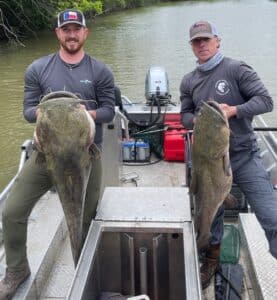Though species diversity in nature is typically a good thing, there are several undesirable fish species that fisheries biologists don’t like to see in small lakes and ponds. The time, effort, and money invested in creating a quality angling resource can be compromised by these uninvited guests. Most of these species are found widespread in rivers, creeks, and ditches and can be challenging to keep out of ponds with large watersheds.

Undesirable Species
The most familiar undesirable fish species in north Texas is the common carp. This is an exotic species which is native to Europe and Asia. However, they are now present in almost all lakes, rivers, and streams in Texas. Common carp lay millions of eggs a year and can grow to 4 feet long. Adult carp are notorious for rooting in the bottom sediments in search of food; which increases water turbidity. Poor water clarity negatively impacts gamefish populations by inhibiting healthy phytoplankton production and reducing the efficiency of sight feeding predators. The end result is poor bass growth and reproduction. Unfortunately, there is no proven method to selectively eradicate common carp from a pond. In severe infestations, the best solution may be to completely renovate the pond using a fish toxicant called rotenone. Rotenone should only be applied by a professional applicator who holds a TDA Aquatic Pest license. Periodic electrofishing can also be used to target and remove common carp.
As fisheries managers, we are often asked to stock crappie in small ponds and lakes. Crappie are an important gamefish and top-quality table fare. However, we do not recommend stocking crappie in lakes less than 100 surface acres. Both black and white crappie compete directly with small bass for available forage. They are very prolific and capable of producing extremely high numbers of offspring in a single season. As a result, they can quickly take over a small pond and stunt at 3-5 inches long. Even in larger lakes, it is crucial to have good numbers of adult largemouth bass in order to keep crappie numbers in check.
The green sunfish is broadly thrown into the “perch” category along with more desirable species like bluegill and redear sunfish. However, their behavior is more similar to that of crappie and juvenile bass. Their aggressive nature and oversized mouth allow them to compete directly with young bass for food. They also challenge desirable sunfishes for nesting space; often interbreeding with bluegill. Due to their scrappy nature, green sunfish are often caught by anglers targeting bass with larger lures. We recommend that all green sunfish be removed from the pond whenever captured.

Flathead Catfish
The flathead catfish can be considered the “JAWS” of the freshwater world. This undesirable fish also goes by the names of yellow cat, mudcat, and Opelousas. They can grow to 120 pounds and are a popular target of hand fishermen or “noodlers”, trot-liners, and jug-liners. Flathead catfish prefer live prey and have a voracious appetite for anything that swims……..including your quality sized bass. They are not known to take over a pond in high numbers; however, a single individual is capable of doing significant damage to a valuable gamefish population. We recommend the immediate removal of any flathead catfish that may be caught. Many southerners consider smaller flathead catfish to be excellent table fare.
